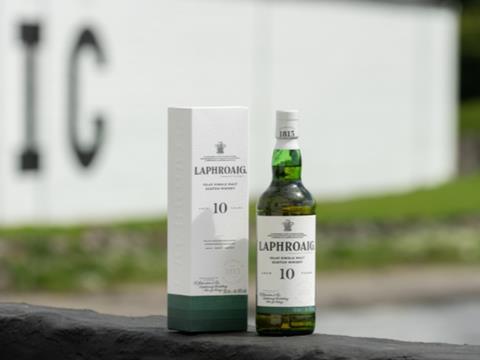
The packaging for Scotch whisky Laphroaig is undergoing a redesign with its sights set on a 30% carbon footprint reduction in line with Beam Suntory’s aim to achieve net zero carbon emissions across its value chain by 2040.
Although it maintains the green bottle and black and white label of the previous design, the new packaging replaces the previous plastic bar top with a beech wood alternative and is now packaged in a carton instead of a secondary packaging tube. This is expected to reduce 1,184.74 tons of greenhouse gases every year.
Embossed Laphroaig lettering has been implemented into the side of the carton in reference to the brand’s Islay distillery, alongside a hand-crafted distillery address on the front and an updated wordmark. Each aims to facilitate high-quality branding for the whisky.
It is hoped that the overall redesign will contribute towards Beam Suntory’s Proof Positive sustainability strategy which, amongst other goals, anticipates a 30% reduction in Scope 1, 2, and 3 emissions, as well as a transition into 100% recyclable packaging, by 2030.
“The Laphroaig distillery has been making whisky for over 200 years, and it is fundamentally important we take steps to reduce our environmental impact and protect the natural resources we rely upon,” said Chris Richardson, VP Global Scotch & Irish Brands, Beam Suntory. “This new packaging is a good step forward in our global sustainability ambitions, while still maintaining Laphroaig’s true character and exceptionally high quality.”
A visual rebrand for Cobra Beer seeks to draw a correlation between the drink and Pan-Asian cuisine, while Heineken Enterprise’s Pélican craft beer cans are being decorated with Ardagh Metal Packaging’s H!GHEND printing technology to encourage consumers to flip the pack and optimise the drink’s flavour.
Additionally, anti-plastic campaigning soda brand GUNNA Drinks is rolling out aluminium bottles for three of its immune boosting lemonades; this is anticipated to drive down plastic waste and meet growing demand for functional food and drink products.
If you liked this article, you might also enjoy:
The Lidl approach to packaging sustainability
How did Brazil achieve its 100% aluminium can recycling rate – and can it be replicated in the EU?
Experts have their say on the EU’s Packaging and Packaging Waste Directive revisions
A deep dive into the most important packaging sustainability trends and solution











No comments yet